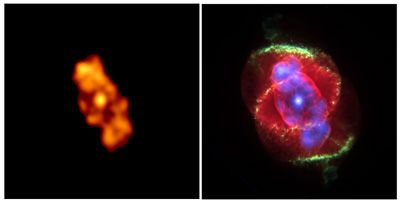January 8, 2001
CXC PR: 01-01
SAN DIEGO -- Scientists have discovered a glowing bubble of hot gas and an unexpected X-ray bright central star within the planetary nebula known as the Cat's Eye using NASA's Chandra X-ray Observatory. The new results, presented today at the American Astronomical Society meeting, provide insight into the ways that stars like our Sun end their lives.
Scientists believe they are witnessing the expulsion of material from a star that is in the last stages of its existence as a normal star. Material shed by the star is flying away at a speed of about 4 million miles per hour, and the star itself is expected to collapse to become a white dwarf star in a few million years.
The X-ray data from the Cat's Eye Nebula, also known as NGC 6543, clearly show a bright central star surrounded by a cloud of multimillion-degree gas. By comparing the Chandra data with those from the Hubble Space Telescope, researchers are able to see where the hotter, X-ray emitting gas appears in relation to the cooler material seen in optical wavelengths by Hubble.
"Despite the complex optical appearance of the nebula, the X-ray emission illustrates unambiguously that the hot gas in the central bubble is driving the expansion of the optical nebula," said You-Hua Chu of the University of Illinois and lead author of the paper submitted to the Astrophysical Journal. "The Chandra data will help us to better understand how stars similar to our Sun produce planetary nebulas and evolve into white dwarfs as they grow old."
With Chandra, astronomers measured the temperature of the central bubble of X-ray emitting material, and this presents a new puzzle. Though still incredibly energetic and hot enough to emit X-rays, this hot gas is cooler than scientists would have expected from the stellar wind that has come to stagnation from the initial high speed of 4 million miles per hour.
At first, the researchers thought that the cooler, outer shell might have mixed with the energetic material closer to the central star to create this "lukewarm" area. However, this theory apparently does not apply for NGC 6543. Chu and her colleagues found that the chemical abundances within the hot gas were like those in the wind from the star, and different from the cooler outer material. These results indicate that mixing is not occurring, and that the cooling between the inner and outer shells of material is due to some other process.
The intensity of the X-rays from the central star was also unexpected. The star itself has a surface temperature of about 60,000 degrees, whereas the X-ray measurement indicates a temperature of a few million degrees.
"We could be seeing shock waves in the fast stellar wind itself," said Martin Guerrero of the University of Illinois, lead author on a companion paper that describes the central star. "This is the first time we see such X-ray emission from the central star of a planetary nebula."
A planetary nebula (so called because it looks like a planet when viewed with a small telescope) is formed when a dying red giant star puffs off its outer layer, leaving behind a hot core that will eventually collapse to form a dense star called a white dwarf. A fast wind emanating from the hot core rams into the ejected atmosphere, pushes it outward, and creates the graceful filamentary structures seen with optical telescopes.
With Chandra, it is now possible to see the high-pressure hot bubble inside these filaments and study how the nebula is formed in more detail. The Cat's Eye Nebula, which is about 3,000 light years from Earth, was formed about a thousand years ago.
Other members of the research team include Robert Gruendl, and James Kaler (University of Illinois), and Rosa Williams (National Research Council). NGC 6543 was observed with the Advanced CCD Imaging Spectrometer (ACIS) on May 10-11, 1999, for a total exposure time of 46,000 seconds.
The ACIS X-ray camera was developed for NASA by Pennsylvania State University and MIT. NASA's Marshall Space Flight Center in Huntsville, AL, manages the Chandra program. TRW, Inc., Redondo Beach, California, is the prime contractor for the spacecraft. The Smithsonian's Chandra X-ray Center controls science and flight operations from Cambridge, MA.
The color composite of optical and X-ray images was made by Zoltan G. Levay (Space Telescope Science Institute). The optical images were taken by J.P. Harrington and K.J. Borkowski (University of Maryland) with the Hubble Space Telescope.
During the AAS meeting, the scientists involved in this release can be reached at the AAS Press Room at the Town & Country Resort in San Diego, CA. The phone numbers for the Press Room are (619) 908-5057, (619) 908-5040, and (619) 908-5041 from January 8-11.
Images associated with this release are available on the World Wide Web at:
MEDIA CONTACTS
Dolores Beasley
NASA HQ
Phone: 202-358-1753
Steve Roy
Marshall Space Flight Center, Huntsville, AL
Phone: 256-544-6535
Megan Watzke
Chandra X-ray Observatory Center, CfA, Cambridge, MA
Phone: 617-496-7998



